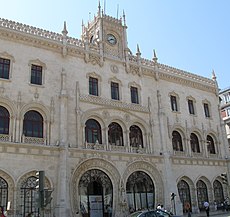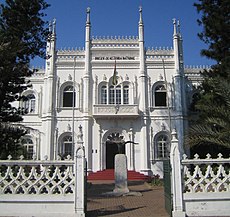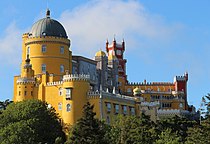Neo-Manueline
Europe, the Americas, & Africa
Neo-Manuelineis arevival styleof architecture which drew from the 16th centuryManuelineLate Gothic architecture of Portugal. Neo-Manueline constructions have been built acrossPortugal,Brazil,and theLusophone world(the formerPortuguese Empire).
History
[edit]The termmanuelinowas introduced in 1842 byBrazilianart historianFrancisco Adolfo de Varnhagen[1]to designate the exuberant artistic style that developed during the reign ofManuel I of Portugal(1495–1521). TheManuelinestyle coincided with theAge of Discoveryand the peak of Portuguese maritime power. In the sequence of theGothic Revival architecturefashion that spread for all over Europe since the middle of the 18th century, the Manueline style was considered the most authentic Portuguesearchitectural style.
Neo-Manueline started with the construction of thePena PalaceinSintrabyFerdinand IIbetween 1839 and 1849.[2]Another pioneering project was the restoration of theJerónimos MonasteryinLisbonduring the 1860s, in which the Manueline monastery gained a new tower and annexes built in Neo-Manueline style (which now house theMaritime Museumand theNational Archaeology Museum). During this time the iconicBelém Towerwas also restored with several Neo-Manueline additions. Other important Neo-Manueline buildings in Portugal areRossio Railway Station,Lisbon(1886–90),Palace Hotel of Bussaco(1888–1907), the Sintra Town Hall (1906–09), the Counts of Castro Guimarães Palace inCascais(1900) and theQuinta da RegaleirainSintra(1904–10). The Neo-Manueline was also used in smaller buildings like private houses.
Neo-Manueline eventually spread to the colonies and former Portuguese colonies. InBrazil,there are several Neo-Manueline buildings, usually built by Portuguese associations.[3]The most important of these is theReal Gabinete Português de Leitura(Royal Portuguese Library), built between 1880 and 1887 by Portuguese immigrants in the centre ofRio de Janeiro.[4]Other Manueline buildings in Brazil include the Portuguese Center inSantos(Centro Português de Santos,1898–1901), the Portuguese Library ofBahia(1915–18) and the Portuguese Literary Liceum (Liceu Literário Português) in Rio de Janeiro (1938).
Examples of Neo-Manueline buildings can also be found in African and Asian territories of the formerPortuguese Colonial Empire.
There are also examples of buildings influenced by the Neo-Manueline style in countries that were not directly related with the Portuguese culture. A fine example is theArseny Morozov House(1895–99) inMoscow,Russia.
Gallery
[edit]-
Pena Palace in Sintra, Portugal.
-
Buçaco Palace Hotel inSerra do Buçaco,Portugal
-
Quinta da Regaleirain Sintra, Portugal
-
Liceu Literário Portuguêsin Rio de Janeiro, Brazil
-
Soure Town Hall inSoure,Portugal
-
Gabinete Português de Leiturain Bahia, Brazil
-
Counts of Castro Guimarães Palace inCascais,Portugal
-
Sintra Town Hall in Sintra, Portugal
-
Natural History Museum in Maputo, Mozambique
-
Morozov Palace inMoscow,Russia
See also
[edit]References
[edit]- ^Revista de História da Biblioteca Nacional (01/03/2006)Archived2011-05-19 at theWayback Machine
- ^Pena Palace in the IPPAR website
- ^Regina Anacleto. Arquitectura Neomanuelina no Brasil.Revista Camõesn.11, 2006Archived2016-03-03 at theWayback Machine
- ^Real Gabinete Português de Leitura official websiteArchived2008-12-28 at theWayback Machine















